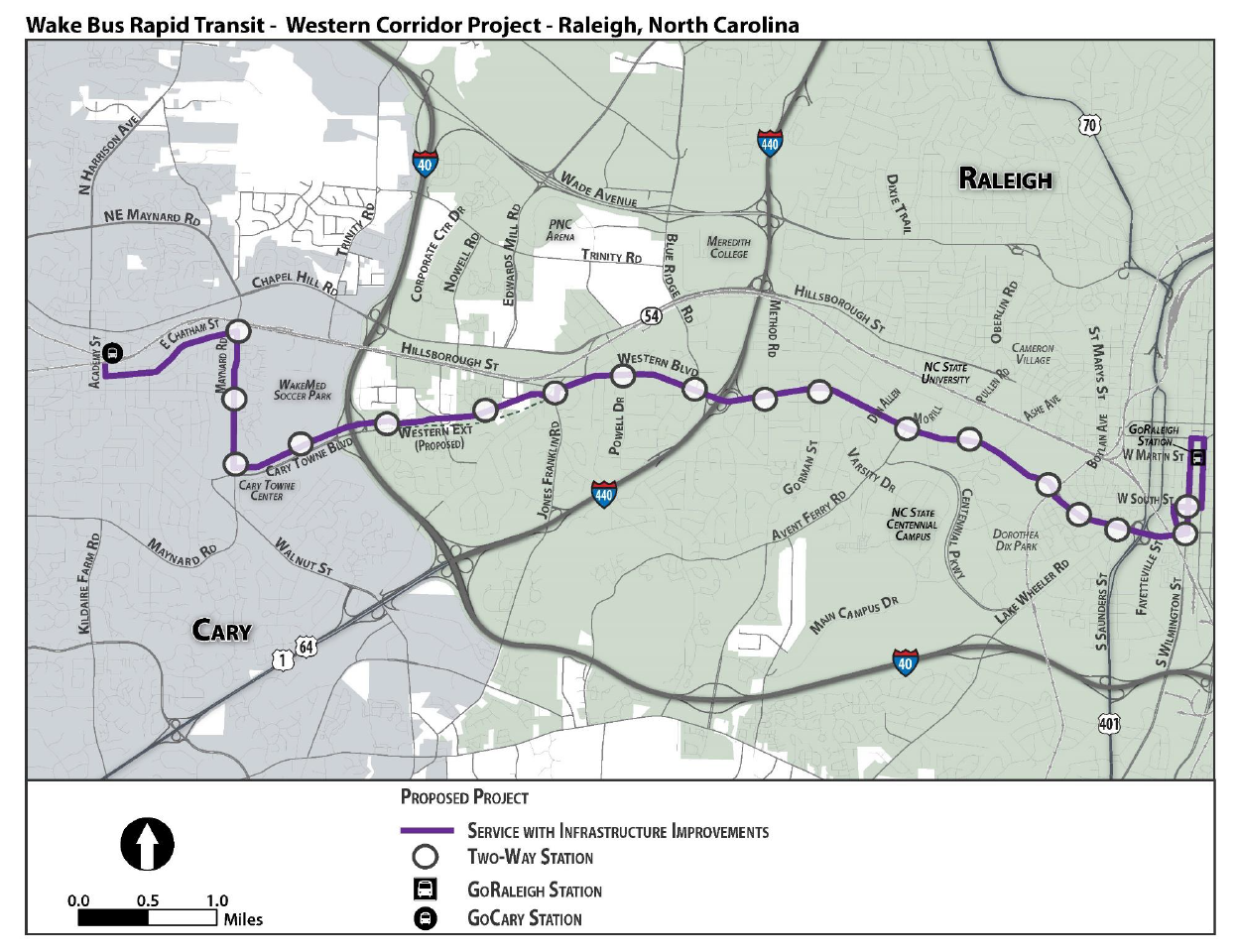Wake BRT: Western Corridor
Locally Preferred Alternative for the Wake Bus Rapid Transit (BRT): Western Corridor
The CAMPO Executive Board adopted the LPA at its meeting on November 18, 2020.
The City of Raleigh is in the process of developing and implementing a bus rapid transit (BRT) project along the Western Boulevard/Cary Towne Boulevard/Maynard Road/Chatham Street corridors to connect the Raleigh central business district with downtown Cary, a total span of approximately 11 linear miles (map). The proposed project would include new dedicated transit guideway and infrastructure improvements along at least 50 percent of the total corridor between the GoRaleigh Station, in Downtown Raleigh, and a future downtown Cary multimodal transit facility in the vicinity of the existing Cary train station. The proposed project would include transit signal priority (TSP) at signalized intersections and up to 18 weather‐protected BRT stations. The terminus at a future downtown Cary multimodal transit facility will include a proposed park-and-ride and transfer facility that will be implemented as a separate project.
The purpose of the Wake Bus Rapid Transit (BRT): Western BRT Corridor project is to improve transit service from Downtown Raleigh to Downtown Cary. This new transit investment would accommodate projected growth, create transit infrastructure that allows the BRT route and other approved transit services to bypass major congestion points, and improve the attractiveness of the service to experience ridership growth.
The Wake County Transit Plan (2016) originally identified the Western Boulevard and Chatham Street corridors as the Wake BRT: Western Corridor between downtown Raleigh and downtown Cary. The Wake Transit Fixed Guideway Corridors Major Investment Study (MIS) (2018) further refined this BRT alternative by identifying a single alignment option between downtown Raleigh and Jones Franklin Road. This alignment would use a combination of Wilmington, Salisbury, Blount, South, and Morgan Streets in downtown Raleigh and the existing alignment of Western Boulevard from downtown Raleigh to Jones Franklin Road. The MIS and further subsequent alternatives analysis carried out by the City of Raleigh and Town of Cary generated four (4) alignment options for the corridor between Jones Franklin Road and downtown Cary, which include:
- Chapel Hill Road (NC 54): The Chapel Hill Road/NC 54 alternative would use Hillsborough Street and Chapel Hill Road between the intersection of Western Boulevard/Hillsborough Street and downtown Cary. This segment is approximately 4.1 miles in length.
- Chatham Street: The Chatham Street alternative would use Hillsborough Street and Chatham Street between the intersection of Hillsborough Street/Western Boulevard/Jones Franklin Road and downtown Cary. This segment is approximately 3.1 miles in length.
- Cary Towne Boulevard/Walnut Street: The Cary Towne Boulevard/Walnut Street alternative would use an extension of Western Boulevard on new location, Cary Towne Boulevard, and Walnut Street between the Western Boulevard/Jones Franklin Road intersection and downtown Cary. This segment is approximately 3.9 miles in length.
- Cary Towne Boulevard/Maynard Road/East Chatham Street: The Cary Towne Boulevard/Maynard Road alternative would use an extension of Western Boulevard on new location, Cary Towne Boulevard, Maynard Road, and East Chatham Street between the Western Boulevard/Jones Franklin Road intersection and downtown Cary. This segment is approximately 4.7 miles in length.
The Cary Towne Boulevard/Maynard Road/Chatham Street alignment has been recommended by the City of Raleigh and Town of Cary as the most suitable alternative for adequately serving the travel market that satisfies the purpose and need for the project. This alignment was recommended to CAMPO by the City of Raleigh as the locally preferred alternative (LPA). This alignment provides direct access to more existing and future trip-generating origins and destinations along the corridor, accommodates more transit-oriented economic development potential, and provides access to more disadvantaged transit-dependent populations than the other alignment alternatives. It was determined that the proposed BRT mode along the described alignment and with the described termini is the most cost-effective and least intrusive mode that can achieve the purpose and need for the project. The BRT mode improves throughput capacity and transit service reliability to a level that is adequate to serve the existing and projected travel market without introducing significant impacts to the corridor.
On July 23, 2020, the Cary Town Council endorsed the segment of the recommended LPA that lies within the Cary Town limits. On August 18, 2020, the Raleigh City Council recommended the described alternative as the LPA to CAMPO for its consideration of adoption and inclusion in the 2045 Metropolitan Transportation Plan and FYs 2020-2029 Transportation Improvement Program (TIP). The CAMPO Executive Board adopted the LPA at its meeting on November 18, 2020.
